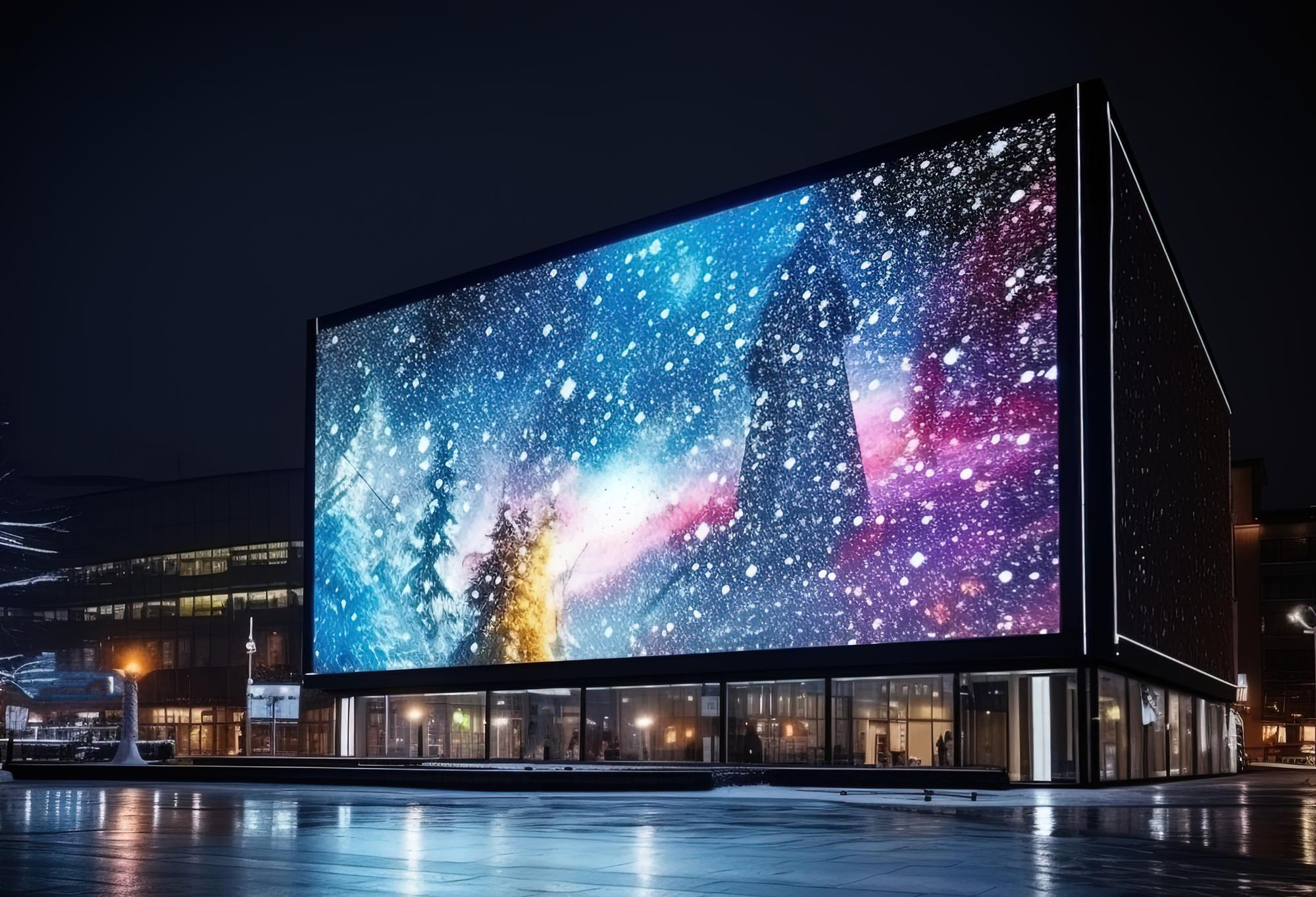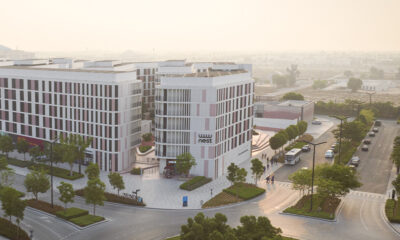Tech Features
From Display to Destination: How LED Tech Is Rewriting Outdoor Retail in the GCC

In the Gulf’s fast-evolving retail landscape, one thing is clear: attention is everything. With consumers moving between screens, stores, and digital channels in seconds, capturing that attention outdoors is becoming a high-stakes game. That’s why LED display technology is rapidly becoming the new storefront essential, especially when paired with interactivity.

Retailers across the UAE, Saudi Arabia, and Qatar are investing in large-format LED displays that do more than just promote products; they invite shoppers in. Whether it’s a vivid display on a flagship store’s exterior or an interactive screen at a luxury mall, brands are embracing motion, light, and tech to cut through the noise. Across malls in Dubai, Doha, and Riyadh, it’s no longer uncommon to see storefronts come alive with animations, responsive visuals, or even gesture-based content.
“Retailers today are competing not just for sales, but for attention, and in this region, that means making a bold visual impact,” said Zac Liang, General Manager – Gulf Area, Unilumin Group. “That’s why more brands are investing in outdoor LED displays that don’t just advertise, they engage.”
While many regions are adopting this trend, the Middle East is scaling fast. According to Grand View Research, the digital signage market in the Middle East and Africa is expected to grow from USD 1.66 million in 2024 to USD 2.80 million by 2030, with the GCC leading the charge thanks to infrastructure development, smart city strategies, and a strong mall culture. This growth is being fueled by the rising demand for immersive experiences, particularly in high-traffic outdoor retail environments.
The shift isn’t just about visuals; it’s also about interactivity. LED displays equipped with touchscreens, motion sensors, and augmented reality are turning passive browsing into active engagement. Shoppers can explore digital lookbooks, scan QR codes for real-time offers, or interact with content that responds to their presence. These experiences help bridge the online-offline divide, giving brands a powerful edge in driving foot traffic and customer engagement.
“Interactivity is no longer a luxury; it’s a necessity,” Liang added. “Our clients in the Gulf are asking for displays that do more than play content. They want screens that connect, respond, and adapt in real time.”
Unilumin has been at the forefront of this transformation. The company made waves by being the first in the LED industry to introduce MIP/COB technology for outdoor displays in China; the technology is now making its way into major Middle Eastern markets. At the 19th Hangzhou Asian Games, Unilumin deployed over 4,200 square meters of LED screens across key venues. Its outdoor COB display at West Lake, the world’s first outdoor high-brightness COB screen, not only lit up the event but became part of the visual narrative of the games.
That same energy is now flowing into the Gulf, where malls, airports, and open-air retail zones are hungry for solutions that combine aesthetics, interactivity, and performance. From arch-shaped LED portals in Dubai to street-facing media walls in Doha, the region is becoming a live canvas for digital storytelling.
The future of outdoor retail in the GCC isn’t just about visibility; it’s about visibility with purpose. Interactive LED displays give brands the power to stop shoppers mid-scroll, pull them off the sidewalk, and get them through the door. In a market where first impressions are everything, those few seconds on the street could mean the difference between a passerby and a purchase.
Tech Features
HOW GCC OPERATORS CAN LEAD THE NEXT AI WAVE WITH FUTURE-PROOF OPTICAL NETWORKS

By Pete Hall, Regional Managing Director, Ciena Middle East & Africa
Artificial Intelligence (AI) is advancing at a rapid pace in the region, driving innovation across various industries. The GCC now stands at a pivotal moment, with AI transitioning from a hyperscaler-centric phenomenon to a ubiquitous force shaping enterprise and consumer networks alike.
Globally, Amazon Web Services (AWS), Google Cloud, Microsoft Azure and NVIDIA have stepped in to manage large-scale computing and data processing needs. Unlike traditional data centers, they are built to meet evolving workloads without major infrastructure changes.
The rapid expansion of data centres to meet soaring demand is also evident in the UAE, where du announced a deal with Microsoft to set up a data centre in the country to revolutionize the digital ecosystem. Next door, Saudi Arabia has been expanding its investments in data centres to drive its wider ambitions to become a regional AI leader and global tech hub.
While much of the AI optics boom has so far been confined to data center interconnects, growth is now shifting from AI model training to AI inferencing, where AI models can make accurate predictions based on new data. However, it takes data-intensive AI training to make this a reality.
As new AI applications such as AI-powered analytics, immersive media, and automation are expected to surge through 2030, the next wave will demand robust, low-latency, high-capacity optical transport across metro and long-haul networks.
In particular, GCC markets are primed to experience rapid uptake due to national AI agendas and smart city initiatives. A 2025 survey shows AI traffic could account for 30–50% of metro and long-haul capacity within three years. It is interesting to note that enterprises, not hyperscalers, are expected to drive the most network traffic growth over this period.
As the AI traffic boom moves beyond the data centre, low latency, high capacity, and resilient optical links will be the key differentiators for AI-driven workloads. This is precisely where regional telcos can take the lead. The market for capacity is already evolving quite rapidly.
Earlier this year, e& UAE became the first in the Middle East and Africa to deploy Ciena’s WaveLogic 6 Extreme, achieving ultra-high-speed 1.6 Tb/s per wavelength connectivity. This advancement supports 10 Gb home services and wholesale and domestic business customer traffic with 100G and 400G requirement.
The GCC’s investment in high-capacity optical networks, powered by new innovations such as WaveLogic 6, provides a competitive advantage in meeting the increasing AI traffic demands. If they are to take this to the next level, GCC telcos must capitalize on their relatively greenfield networks to deploy future-proof optical infrastructures faster than more mature markets constrained by legacy systems.
GCC operators are charting a new course as AI enablers, leveraging managed optical fiber networks and AI-optimized SLAs to deliver greater value and innovation beyond traditional bandwidth services.
To accelerate this journey and speed time to market, operators are also taking steps to address capex constraints, skill gaps, and organizational alignment. By positioning themselves as AI ecosystem leaders, they can unlock long-term revenue and resilience.
There is a real window of opportunity for GCC operators to capitalise on the AI optical wave. Thanks to national AI strategies, sovereign cloud initiatives, and hyperscaler partnerships, they already have a head start. By continuing to invest in future-proof, high-capacity, low-latency optical networks they can ensure network readiness for AI’s exponential traffic growth. The next three years will determine whether GCC operators shape the AI economy or chase it.
Tech Features
5 KEY TECHNOLOGY TRENDS AFFECTING THE SECURITY SECTOR IN 2026

By Johan Paulsson, Chief Technology Officer at Axis Communications; Matt Thulin, Director of AI & Analytics Solutions at Axis Communications; and Thomas Ekdahl, Engineering Manager – Technologies at Axis Communications
It came as a surprise that this is the 10th time that we’ve looked at the technology trends that we think will affect the security sector in the coming year. It feels like only yesterday that we sat down to write the first – a reminder of how quickly time passes, and how fast technological progress continues to move.
Something that’s also become clear is that a completely new set of trends doesn’t appear year-on-year. Rather, we see an evolution of trends and technological developments, and that’s very much the case as we look towards 2026. Technological innovations regularly arrive, which impact our sector. Artificial intelligence, advancements in imaging, greater processing capabilities within devices, enhanced communications technologies…these and more have impacted our industry.
Even technologies which still seem a distance away, such as quantum computing, may have some potential implications in the near-term in preparing for the future. While we focus here on tech trends, it’s worth highlighting a shift that we’ve seen in recent years: the increasing involvement and influence of the IT department over decisions related to security and safety technology. The physical security and IT departments now work in close collaboration, with IT heavily involved in physical security purchasing decisions.
That influence, we feel, is central to the first of our trends for 2026…
1. “Ecosystem-first” becomes an important part of decision making
At a fundamental level, the greater influence of the IT department is changing the perspective regarding security technology purchasing decisions. We call this an “ecosystem-first” approach, and it influences almost every subsequent decision. Today, however, we start to see a trend that the first decision is increasingly defined by the solution ecosystem to which the customer wants to commit. In many ways, it’s analogous to how IT has always worked: decide on an operating system, and then select compatible hardware and software.
The ecosystem-first approach makes a lot of sense. With today’s solutions including a greater variety of devices, sensors, and analytics than ever before, seamless integration, configuration, management, and scalability is essential. In addition, product lifecycle management, including, critically, ongoing software support, becomes more achievable within a single ecosystem.
Committing to a single ecosystem – one offering breadth and depth in hardware and software from both the principal vendor alongside a vibrant ecosystem of partners – is the primary decision.
2. The ongoing evolution of hybrid architectures
A hybrid architecture as the preferred choice isn’t new. In fact, it’s something we’ve highlighted in previous technology trends posts. But it continues to evolve. Sometimes evolution can seem quite subtle. In reality, we’re seeing some fundamental shifts.
We’ve always described hybrid as a mix of edge computing within cameras, cloud resources, and on-premise servers. While that’s still the same today, what’s changing is the balance of resources, as capabilities are enhanced and new use cases emerge. Edge and cloud are becoming much more significant, with the need for on-premise server computing resources reduced.
This is largely a result of enhanced computing power and capabilities within both cameras and the cloud. More powerful edge AI-enabled surveillance cameras can, put simply, handle more than ever before. Improved image quality, the ability to more accurately analyze scenes and create valuable metadata have seen cameras take on tasks previously handled on the server.
Similarly, with such a wealth of data being created, cloud-based resources have the analytical power required to surface business intelligence and insights to enhance operational effectiveness.
There can still be legitimate reasons to retain some on-premise resources, such as network video recorders, but the true value is increasingly coming from edge devices and cloud resources. Ultimately, it’s a trend that meets both the IT department’s drive for efficiency, the security team’s desire for solution quality and effectiveness, and the data integrity and security needs of both.
But, even if hybrid architectures are a trend, we must not forget that a vast majority of all solutions are still very much on-prem solutions, and this will be the case for a long time.
3. The increased importance of edge computing
In many sectors, like the automotive industry, the need and potential for edge computing has only been recognized relatively recently. As regular readers will know, however, the value of increased computing resources within devices at the edge of the network has been a feature of our technology trends predictions for several years. Enhanced capabilities mark the beginning of a new era of edge.
In many ways, the increased importance of edge computing is directly related to the evolution of hybrid architectures described in the previous trend. When hybrid solutions have included edge, cloud, and server technologies, the full potential of edge AI hasn’t always been fully realized. With on-premise servers able to support some tasks, there has been less motivation to move these to the edge.
This is already changing and will accelerate over the coming year. This is in part due to the enhanced AI available to the edge, within devices themselves. The discussion and decisions about where to deploy AI across surveillance solutions – using the strengths of edge AI in devices and the power of cloud-based analytics – has brought focus to the capabilities of cameras and the increasing variety of edge AI-enabled sensors. These bring benefits in both effectiveness and efficiency.
Edge processing generates both business data — actionable insights derived directly from the scene — and metadata, which describes the objects and scenes within it. This information has become the basis for efficient scaling of system functionality, such as smart video searches, and for generating system wide insights. Edge processing enables a much smoother scaling of system compute performance, as the system performance grows with each added edge device.
The arguments against moving more to the edge, such as cybersecurity challenges, have diminished. With the strong cybersecurity capabilities of edge devices, such as secure boot and signed OS, they now have become a strong part of the overall system security solution.
4. Mobile surveillance on the rise
Mobile surveillance solutions, like mobile trailers, aren’t a trend in themselves. For numerous reasons – commercial and technological – mobile surveillance has already seen significant growth and is set to explode over the next year.
From a technological perspective, improved connectivity has helped unlock the ability to employ more advanced, higher-quality surveillance cameras in mobile solutions. Remote access and edge AI has further enhanced the capabilities of mobile surveillance solutions. This immediately makes them an attractive option in a greater variety of situations, from public safety to construction sites to festivals and sporting events.
Power management within surveillance cameras has also advanced, resulting in lower power utilization without a compromise in quality. This is particularly important where mobile surveillance solutions are making use of battery power and renewable energy. A mobile surveillance solution can also be more straightforward to approve than a permanent installation.
Ultimately, these factors mean that security and safety can be ensured in places where it is difficult or undesirable to place physical security personnel.
5. Technology autonomy: Easier said than done!
Less a new trend, and more a reflection on one of our trends from last year where we highlighted how companies across many sectors were looking to gain more control over key technologies essential to their products. Automotive companies looking to design their own semiconductors to mitigate against supply chain disruption was an example.
As many of those organizations are finding, however, extending an organization’s focus from its traditional business (e.g. making cars) to a fundamentally different and potentially highly complex area (e.g. designing semiconductors) is easier said than done. Attempts also highlight how interconnected global supply chains are, and that true autonomy is impossible to achieve.
As we have done for many years here at Axis, focus for technological autonomy should be on the areas of a business that make a fundamental difference to the offering. Designing our own system-on-chip (SoC), ARTPEC, which Axis started doing more than 25 years ago, has given us ultimate control over our product functionality.
An example of the benefit of this has been our ability to be the first surveillance equipment vendor to provide AV1 video encoding to our customers and partners, in addition to H.264 and H.265. It also allows us to prepare for future technologies that will bring opportunities and risks, even those that still seem many years in the future.
While we always enjoy putting together our thoughts on the trends that will define the industry over the coming year, our perspective stretches much further into the future. This is what gives us the ability to plan for and develop the innovations that continue to meet the evolving needs of customers, and opportunities to improve safety, security, operational efficiency and business intelligence.
Innovation doesn’t happen in isolation, however. The best ideas emerge through collaboration, by listening to our customers and understanding their challenges, by maintaining close relationships with our partners, and by exploring solutions together. These partnerships are what will continue to drive progress as we move into 2026 and beyond, whichever way the technological winds may blow.
Tech Features
GenAI App Ad Spend Hits US$824M as AppsFlyer Reveals First AI Agent Usage Data

AppsFlyer has released its annual analysis of mobile app trends, revealing how AI shaped both consumer behavior and marketing strategy in 2025. GenAI adoption accelerated across the app ecosystem, with installs up 16% and category spend reaching US$824M across iOS and Android. GenAI apps ranked among the fastest-growing categories of the year, no.1 in Android and no.4 in iOS, reflecting their expanding role in creative, productivity, and AI assistant experiences.
AppsFlyer also analyzed AI agent usage for the first time, identifying how marketers are integrating AI into their performance workflows. The data shows that 57% of agent deployments focused on technical automation such as configuration and data-integrity checks, while 32% supported business optimization. Distinct usage patterns emerged across verticals: gaming marketers used agents to improve efficiency and protect margins, while retail and fintech teams relied on them to scale traffic and volume. These trends point to an early but meaningful shift toward supervised automation, where AI supports decision-making while marketers maintain strategic oversight.
“Many marketers say they are still struggling to measure clear ROI from AI, yet the adoption curve tells a different story,” said Inna Weiner, VP Product, Data and AI, AppsFlyer. “GenAI apps are accelerating in consumer adoption, and behind the scenes marketers are increasingly deploying agents to simplify workflows and improve efficiency. AppsFlyer remains committed to helping teams navigate this rapidly evolving landscape with the clarity and confidence they need to grow.”
Beyond the rise of AI in both apps and marketing workflows, the report outlines several broader trends shaping the app economy in 2025.
Additional Marketing Trends of 2025
- Global UA spend rises 13% to US$78B, driven entirely by iOS and mostly by investment from non-gaming apps: iOS user acquisition spend grew 35% while Android remained flat. Non-gaming increased 18% to US$53B, and gaming grew only 3% to US$25B.
- Remarketing expands as retention gains importance: Remarketing spend grew a significant 37% to US$31.3B, now representing 29% of all app marketing investment (up from 25% in 2024). iOS remarketing rose 71%, with notable gains in Transportation (+362%), Travel (+145%), and Finance (+135%).
- Shopping reshapes global UA spend distribution: Shopping investment to acquire new users rose 70% overall and 123% on iOS, driven by China-based ecommerce budgets that materially shifted category and regional share.
-

 Tech News1 year ago
Tech News1 year agoDenodo Bolsters Executive Team by Hiring Christophe Culine as its Chief Revenue Officer
-

 VAR8 months ago
VAR8 months agoMicrosoft Launches New Surface Copilot+ PCs for Business
-

 Tech Interviews2 years ago
Tech Interviews2 years agoNavigating the Cybersecurity Landscape in Hybrid Work Environments
-

 Tech News5 months ago
Tech News5 months agoNothing Launches flagship Nothing Phone (3) and Headphone (1) in theme with the Iconic Museum of the Future in Dubai
-

 Tech News2 years ago
Tech News2 years agoBrighton College Abu Dhabi and Brighton College Al Ain Donate 954 IT Devices in Support of ‘Donate Your Own Device’ Campaign
-

 VAR1 year ago
VAR1 year agoSamsung Galaxy Z Fold6 vs Google Pixel 9 Pro Fold: Clash Of The Folding Phenoms
-

 Editorial1 year ago
Editorial1 year agoCelebrating UAE National Day: A Legacy of Leadership and Technological Innovation
-

 Cover Story10 months ago
Cover Story10 months agoUnifonic Leading the Future of AI-Driven Customer Engagement























